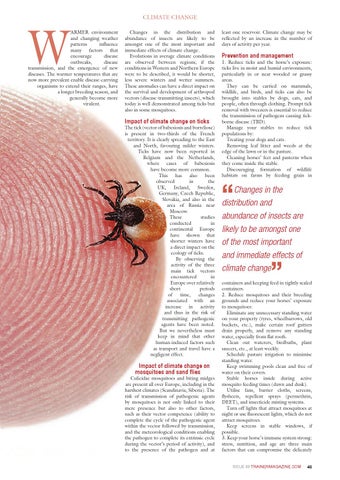W
ARMER environment and changing weather patterns influence many factors that encourage disease outbreaks, disease transmission, and the emergence of new diseases. The warmer temperatures that are now more prevalent enable disease-carrying organisms to extend their ranges, have a longer breeding season, and generally become more virulent.
CLIMATE CHANGE Changes in the distribution and abundance of insects are likely to be amongst one of the most important and immediate effects of climate change. Evolutions in average climate conditions are observed between regions; if the conditions in Western and Northern Europe were to be described, it would be shorter, less severe winters and wetter summers. These anomalies can have a direct impact on the survival and development of arthropod vectors (disease-transmitting insects), which today is well demonstrated among ticks but also in some mosquitoes.
Impact of climate change on ticks
The tick (vector of babesiosis and borreliose) is present in two-thirds of the French territory. It is clearly spreading to the East and North, favouring milder winters. Ticks have now been reported in Belgium and the Netherlands, where cases of babesiosis have become more common. This has also been observed in the UK, Ireland, Sweden, Germany, Czech Republic, Slovakia, and also in the area of Russia near Moscow. These studies conducted in continental Europe have shown that shorter winters have a direct impact on the ecology of ticks. By observing the activity of the three main tick vectors encountered in Europe over relatively short periods of time, changes associated with an increase in activity and thus in the risk of transmitting pathogenic agents have been noted. But we nevertheless must keep in mind that other human-induced factors such as transport and travel have a negligent effect.
Impact of climate change on mosquitoes and sand flies
Culicidae mosquitoes and biting midges are present all over Europe, including in the harshest climates (Scandinavia, Siberia). The risk of transmission of pathogenic agents by mosquitoes is not only linked to their mere presence but also to other factors, such as their vector competence (ability to complete the cycle of the pathogenic agent within the vector followed by transmission, and the meteorological conditions enabling the pathogen to complete its extrinsic cycle during the vector’s period of activity), and to the presence of the pathogen and at
least one reservoir. Climate change may be reflected by an increase in the number of days of activity per year.
Prevention and management
1. Reduce ticks and the horse’s exposure: ticks live in moist and humid environments, particularly in or near wooded or grassy areas. They can be carried on mammals, wildlife, and birds, and ticks can also be brought into stables by dogs, cats, and people, often through clothing. Prompt tick removal with tweezers is essential to reduce the transmission of pathogens causing tickborne disease (TBD). Manage your stables to reduce tick populations by: Treating your dogs and cats. Removing leaf litter and weeds at the edge of the lawn or in the pasture. Cleaning horses’ feet and pasterns when they come inside the stable. Discouraging formation of wildlife habitats on farms by feeding grain in
“
Changes in the distribution and abundance of insects are likely to be amongst one of the most important and immediate effects of climate change
”
containers and keeping feed in tightly sealed containers. 2. Reduce mosquitoes and their breeding grounds and reduce your horses’ exposure to mosquitoes: Eliminate any unnecessary standing water on your property (tyres, wheelbarrows, old buckets, etc.), make certain roof gutters drain properly, and remove any standing water, especially from flat roofs. Clean out waterers, birdbaths, plant saucers, etc., at least weekly. Schedule pasture irrigation to minimise standing water. Keep swimming pools clean and free of water on their covers. Stable horses inside during active mosquito feeding times (dawn and dusk). Utilise fans, barrier cloths, screens, flysheets, repellent sprays (permethrin, DEET), and insecticide misting systems. Turn off lights that attract mosquitoes at night or use fluorescent lights, which do not attract mosquitoes. Keep screens in stable windows, if possible. 3. Keep your horse’s immune system strong: stress, nutrition, and age are three main factors that can compromise the delicately ISSUE 49 TRAINERMAGAZINE.COM
EUROPEAN TRAINER ISSUE 49 CLIMATE.indd 45
45
28/03/2015 11:31
